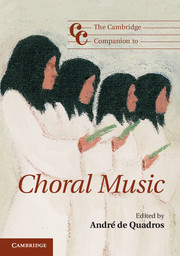Book contents
- Frontmatter
- 1 Introduction: choral music – a dynamic global genre
- Part I Choral music: history and context
- 2 A brief anatomy of choirs c.1470–1770
- 3 Choral music in the culture of the nineteenth century
- 4 Choral music in the twentieth and early twenty-first centuries
- 5 The nature of chorus
- Part II Choral music the world over
- Part III Choral philosophy, practice, and pedagogy
- Notes
- Select bibliography
- Index
- Cambridge Companions to Music
2 - A brief anatomy of choirs c.1470–1770
from Part I - Choral music: history and context
Published online by Cambridge University Press: 28 September 2012
- Frontmatter
- 1 Introduction: choral music – a dynamic global genre
- Part I Choral music: history and context
- 2 A brief anatomy of choirs c.1470–1770
- 3 Choral music in the culture of the nineteenth century
- 4 Choral music in the twentieth and early twenty-first centuries
- 5 The nature of chorus
- Part II Choral music the world over
- Part III Choral philosophy, practice, and pedagogy
- Notes
- Select bibliography
- Index
- Cambridge Companions to Music
Summary
Josquin des Prez, Tallis, Victoria, Monteverdi, Charpentier, Bach – the great choral composers of the past may be presumed to have understood the inner workings of their choirs comprehensively well; most had received a choirboy's education and virtually all spent a lifetime amongst their chosen singers. But to what extent do we share their understanding? Was Dufay's body of singers little different from those that Handel knew some 300 years later? Has “the choir” somehow managed to remain essentially one and the same thing through the ages to our own time? Though much transcribed, discussed and performed, music written for choirs in earlier centuries generally reaches us through a filter of more recent choral expectations, with unfamiliar features disregarded, overlooked, or misconstrued. Thus, while close attention is routinely paid to specific works and their composers, and to compositional genres and choral institutions, the focus here will instead be on the very nature of those diverse musical bodies we call choirs.
Since for much of the period under consideration choral performance was nurtured almost single-handedly by the Church, it will suffice to define a “choir” provisionally as “An organized body of singers performing or leading in the musical parts of a church service.” This has the merit of making no attempt to prescribe how such a body is musically organized (whether for unison singing, or for music requiring just three solo voices or a multiplicity of voices intermixed with instruments), and it therefore encourages us not to concentrate unduly on familiar aspects of “choral” performance as we now understand it.
- Type
- Chapter
- Information
- The Cambridge Companion to Choral Music , pp. 5 - 26Publisher: Cambridge University PressPrint publication year: 2012

